Search the Special Collections and Archives Portal
Search Results

Transcript of interview with Earl and Gloria Alger by Claytee D. White, October 29, 2009
Date
2009-10-29
Archival Collection
Description
Earl and Gloria Alger were born in the early 1930s, met at the Mormon Church, dated in high school and have spent their entire lives in Las Vegas. Earl's story begins with his father arriving to take a construction job at the Boulder Dam. For a year he worked and saved to move his family from Utah to Las Vegas. The family lived on the Westside and Earl recalls he and his brother sharing a tent as their bedroom for a while. Gloria remembers growing up on Garcia Street in the downtown area. Her parents took her to a Liberace show for her 16th birthday, but other than that their lives were centered around the Mormon church. Her great-grandfather Torrel Lewis was one of the original pioneers from Salt Lake City. They describe the good old days of the "old Ranch", "Twin Lakes", and "frogging"; of the changed attitudes of working in gaming by the Mormon community and the more recent changes due to corporation leaders and increased traffic of the population growth.
Text
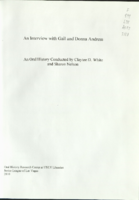
Transcript of interview with Gail and Donna Andress by Claytee White, November 26, 2008
Date
2008-11-26
Archival Collection
Description
The memories and recollections of Gail and Donna Hanley Andress provide a rare and fascinating look at the early days of Las Vegas. They arrived in the early 1930s and, except for relocations due to military service in World War Two, remained active citizens of the town until retiring to Nelson, Nevada, in 1987. Gail's careers spanned a number of occupations, from car dealerships to construction work, and Donna volunteered to serve in a number of community organizations, principally the Service League, the forerunner of the Junior League of Las Vegas. They insist that Nelson is not far from Las Vegas and have remained interested and supportive of many projects in both communities.
Text
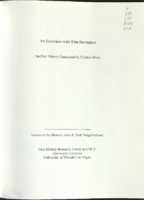
Transcript of interview with Kim Bavington by Claytee White, July 15, 2010
Date
2010-07-15
Archival Collection
Description
In 1964, Kim Bavington's parents moved to Las Vegas when she was six months old. Her father was an industrial designer and mother was an art instructor. In this interview she speaks of growing up in Las Vegas and the various locations where she lived over the course of years, including: eighteen years in Francisco Park, an apartment in Spring Valley, a first house in Green Valley and eventually a home that she and husband Tim Bavington, an artist, own in John S. Park. Kim earned a Fine Art degree from UNLV and worked at a sundry of jobs to support herself. She reflects on this and on how living in Paris, where she took art classes at Sorbonne for six months, dramatically altered her perspective of Las Vegas. Eventually a neighbor situation further changed her feelings about living in a gated community and she knew she wanted to move to what she calls "an old fashion neighborhood." The house search lead her and future husband Tim to John S. Park Neighborhood and a once "super Mid-Century Modem ranch" house. Their large five-bedroom house was built in 1963, has been restored to its original state and is furnished with 1950s furniture.
Text
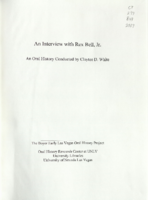
Transcript of interview with Rex Bell Jr. by Claytee D. White, March 2, 2010
Date
2010-03-02
Archival Collection
Description
Growing up on the Walking Box Ranch as the son of movie stars Rex Bell and Clara Bow, attending law school, work in Las Vegas, race relations, and owning a law practice.
Text
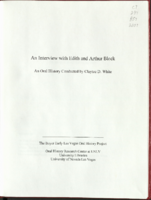
Transcript of interview with Edith and Arthur Bock by Claytee White, September 15, 2009
Date
2009-09-15
Archival Collection
Description
Arthur and Edith Block share memories of their respective childhoods in northern Nevada (Arthur) and East Chicago, Indiana (Edith). Sixty-three years of marriage encompasses Edith's career in banking and Arthur's work in the dry cleaning business and as a highway patrolman. It was his career in law enforcement that drew them to Las Vegas in 1968. Recalling Las Vegas in the sixties and seventies, Edith and Arthur discuss their first home, the hotels and entertainers, integration, and Howard Hughes. They talk about train service, agriculture, Basque influence, and the Thunderbirds in northern Nevada, and what it was like to live in those small rural towns. In contrast, they mention the downtown renovation, heavy traffic, explosive growth, and entertainment options in Las Vegas. In addition to their careers and raising a family, Edith and Arthur talk about their involvement with their church, which provides outreach programs and a certified day school. Arthur mentions working as security for the Summa Corporation after he retired from law enforcement, and Edith provides details about her work in banking. They also comment on the future of Las Vegas/Clark County and express their love for the state of Nevada.
Text

Transcript of interview with Cynthia Cicero, Tina Boag, Betty Brown, and Jan Ravetti by Claytee D. White, March 28, 2014
Date
2014-03-28
Archival Collection
Description
Four women, Cynthia Cicero, Betty Brown, Tina Boag, and Jan Ravetti, recall coming to Las Vegas to obtain jobs during the period of mob ownership in the Las Vegas hotels. Each had a different reason for coming. A recession in Buffalo, New York, brought Cynthia and her husband to Las Vegas to obtain employment; Jan Ravetti’s family moved from Pennsylvania due to her father’s illness and possible employment; parents of Tina Boag, who was born in Paris, were entertainers who travelled and performed extensively; and Milton Prell, opening the Aladdin Hotel and Casino, encouraged Californian Betty Brown to work for him. Cynthia Cicero obtained a job with the City of Las Vegas, but the other three worked on the Strip in the casinos. Their experiences in the hotels show the differences between mob and corporate management since they were working there before and after Howard Hughes purchased six of the large Vegas hotels. The four ladies tell about their work on the Strip from Betty’s experience as a genie at the Aladdin to Tina’s position as a twenty-one dealer. They were acquainted with the casino owners and managers, entertainers like Sammy Davis, Jr. and Dean Martin, and show girls. They also knew first-hand the interactions between mobsters and the public. Food, for example, was a giveaway, an enticement for people to come into the hotel to gamble. They also knew stories about high rollers, the robbery of the baccarat tables at Caesars Palace, and the importance of “taking a fall” including the rewards attached. The ladies describe the shops on downtown Fremont Street and the Strip such as Nina Clark’s, Ronzones, Dillards and Chic Hecht’s as well as Penneys and Sears. A young woman shopped at Suzie Cream Cheese, for example, for the right outfit to wear to Pussy Cat A Go-Go, the rock and roll club on the Strip. Las Vegas also had many good gourmet and ethnic restaurants, piano bars, hotel lounges, and pubs with excellent entertainment. The ladies also describe the difference in the treatment of women during the 1960s and 1970s by men in clubs. Women rarely bought drinks nor did they pay for dinners when with gentlemen. Finally, the ladies compare areas where they lived including McNeil Estates, Heritage Square and the Chisholm-built homes in the Jones-Vegas Drive area. Not to be forgotten, however, are the terrible rain storms that flood streets and the Strip. Serious gamblers in the casinos refused to leave the tables while drenching rains washed cars from the hotel parking lots during the 1970s. Neither did they leave the MGM casino when the hotel caught on fire in1980.
Text
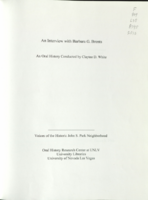
Transcript of interview with Barbara G. Brents Claytee D. White, January 12, 2010
Date
2010-01-12
Archival Collection
Description
When Barbara Brents and her husband Mike moved to Las Vegas in 1987, she had no desire to call it home. It was part of a life adventure, an enchantment with the "Old West" and about a job at UNLV. Sure it wasn't the ivy covered campus, but "the kitsch of Las Vegas was kind of the appeal." Living in John S. Park Neighborhood proved to have a charm on the couple, who have lived in three different homes there. One had a view of Bob Stupak's World of Las Vegas sign and another was used in a scene for the television series Nasty Boys. Their current home was previously owned by Berkeley Bunker, a former U.S. Senator. Over the years they have enticed others to live in John S. Park and continue live there themselves. Barbara shares historic footnotes, political stories, and what lead up to the historic districting of the neighborhood she so dearly cherishes. As she says, "The reason I like Las Vegas is this neighborhood, and I would be gone in a second if this neighborhood died."
Text
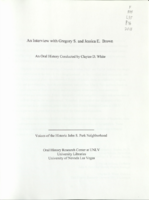
Transcript of interview with Greg and Jessia Brown by Claytee D. White, March 1, 2009
Date
2009-03-01
Archival Collection
Description
Greg Brown arrived in Las Vegas in 1998 to take a position with the history department at UNLV. His future wife had lived here off and on as a child and relocated back to Las Vegas in 2000. In 2002 the couple purchased a home in John S. Park neighborhood. Living in John S. Park Neighborhood can be simultaneously frustrating and wonderful from their point of view. They share thoughts and observations about their experiences on a range of topics, including: local politics and redevelopment, the importance of Mid-Century Modern architecture, the obsolete utility poles, neighborhood beautification, First Fridays, and safety efforts.
Text
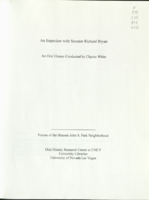
Transcript of interview with Senator Richard Bryan by Claytee White, February 19, 2009
Date
2009-02-19
Archival Collection
Description
Senator Richard Bryan's Las Vegas roots are deep. His father graduated from Las Vegas High School in 1927, left to attend law school and later returned with his young family. His father was politically active and a role model for young Richard, who would succeed in becoming Governor of Nevada in the 1980s and then U.S. Senator. In this interview, Senator Bryan describes his parents looking at a plat map of John S. Park in 1943 and that they bought a house on Maryland Parkway for around $5500.00. He recounts details of the John S. Park neighborhood development and nearby areas and talks about houses with carports rather than garages, no grass, rough asphalt driveways, and a desert where kids could play for hours without supervision. He mentions the impact of World War II on the community, attending movies at the Huntridge Theatre, and becoming a student leader as well as being active in the Boy Scouts. About the Helldorado Days, he talks about the large undertaking of the parade for the Elks Club. As Las Vegas' population grew, the neighborhoods began to fill in. He tells of the opening of schools, including permanent JSP Elementary in 1948 - with no air conditioning. Neighborhood commerce included a grocery store and Sills Drive-in. On the Strip, he remembers Club Bingo (eventually called Sahara) opening as well as the long list of other hotel/casinos that are part of Las Vegas history.
Text
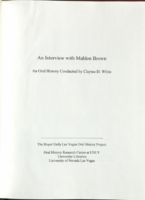
Transcript of interview with Mahlon Brown by Claytee D. White, December 16, 2003
Date
2003-12-16
Archival Collection
Description
Attorney Mahlon Brown begins by talking about his family. His dad was a senator for Nevada, his grandmother was an "amazing, strong, powerful, and insightful" woman, and his mother he describes as beautiful, well-read, and a music lover. He reminisces about his undergraduate days at Howard University and the job he held as a Capitol policeman during the sixties. This included guarding JFK's casket. Mahlon recalls many notable Nevadans that he knew personally, worked closely with, or came up against in meetings or trials. He shares many anecdotes and stories about his contact with Judge Foley, Ronald Pollock, Kenny Guinn, Father Vitali, and Earl White, to mention just a few. He also shares memories of women like Ruby Duncan, Mary Wesley and Maya Miller. Attorney Brown describes the duties of the office of Justice of the Peace which he held for a few years, as well as some of the cases he and Jack Anderson handled when they worked in Legal Services. He also describes the poverty workshop he and Jack ran for three or four years, which gave welfare recipients a chance to air their opinions. Mahlon shares his opinions, insights, and firsthand knowledge of the Mob, Howard Hughes, Mayor Oscar Goodman, Malcolm X, James Brown, integration on the Strip, and many other topics. His personal connections and lengthy history of working and living in Las Vegas make for knowledgeable and entertaining reading.
Text
Pagination
Refine my results
Content Type
Creator or Contributor
Subject
Archival Collection
Digital Project
Resource Type
Year
Material Type
Place
Language
